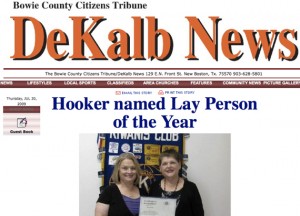This week’s sorry tale of a New York Times reporter being forced to resign for plagiarizing content from The Wall Street Journal, Reuters and other sources, apparently over a long period of time, raises questions about how traditional practices can survive the pressures of the online age.
Zachery Kouwe (right) walked the plank after editors at the Wall Street Journal complained that passages in a post on the Times’ DealBook blog substantially duplicated material published in the Journal a couple of hours earlier. The Times published a correction and later suspended Kouwe. He resigned on Tuesday.
(right) walked the plank after editors at the Wall Street Journal complained that passages in a post on the Times’ DealBook blog substantially duplicated material published in the Journal a couple of hours earlier. The Times published a correction and later suspended Kouwe. He resigned on Tuesday.
In an interview with The New York Observer, Kouwe apologize for the transgression but explained that it was an honest mistake brought on by the need to respond to a rival’s story combined with the relentless pressure to produce weekly output of about 7,000 words. “I was stupid and careless and fucked up and thought it was my own stuff, or it somehow slipped in there. I think that’s what probably happened,” he said.
There’s never an excuse for plagiarism, but an understanding of the environment in which young reporters like Kouwe work can at least explain his acts, if not excuse them.
Deadlines in Minutes
It wasn’t long ago that reporters at a big paper like the Times had the luxury of turning out a story a day or even less. Print deadlines measured in hours offered an opportunity to check sources and rewrite notes in a timeframe that seems positively leisurely today. A few skilled professionals, mostly wire reporters, excelled at deadline reporting. Their expertise in synthesizing and contextualizing large amounts of information, often in chaotic environments, was the product of years of experience.
Today, everyone who writes news online is a wire service reporter. Deadlines are measured in minutes and anyone who wants to compete has to put speed at the top of the agenda. Not everyone is good at working under that kind of pressure, so it’s not surprising that the quality of deadline news reporting is becoming more erratic. Budget cuts at newspapers have also forced a lot of young, relatively unseasoned reporters to the front lines where their work nevertheless carries the moniker of a 150-year-old trusted brand. Such was clearly the case with Kouwe who, at 31, has developed his journalism skills inside the culture and pressure of the Internet.
The craft of note-taking has also changed. In today’s cut-and-paste world, journalists assemble background information from snippets published elsewhere. Notes are typed rather than hand written. In a document made up of first-person interview notes mashed together with clips from other sources, it’s not surprising that the origins of information can become confused. That’s not an excuse for shoddy note-taking, but it is an explanation for how errors can happen.
Changing Views on Copyright
 The standards of intellectual property ownership that have been broadly accepted for so long are also growing fuzzier. Many bloggers don’t even post copyright information on their sites or they choose from one of an assortment of Creative Commons licenses that can themselves be confusing. The nonprofit culture of the blogosphere largely looks the other way when people lift content from each other. Many people use blogs as essentially online notepads, posting everything up to and including their shopping lists. Even if they cared about plagiarism, it’s difficult to spot violations and usually not worth the trouble of chasing the offenders. This works okay in the blogosphere because few bloggers practice their craft for money. In some cases, theft of content is actually considered a compliment to the author.
The standards of intellectual property ownership that have been broadly accepted for so long are also growing fuzzier. Many bloggers don’t even post copyright information on their sites or they choose from one of an assortment of Creative Commons licenses that can themselves be confusing. The nonprofit culture of the blogosphere largely looks the other way when people lift content from each other. Many people use blogs as essentially online notepads, posting everything up to and including their shopping lists. Even if they cared about plagiarism, it’s difficult to spot violations and usually not worth the trouble of chasing the offenders. This works okay in the blogosphere because few bloggers practice their craft for money. In some cases, theft of content is actually considered a compliment to the author.
Then there are the proliferating forms that online communications take. Are Twitter messages copyrightable? If so, then isn’t the coveted retweet a form of copyright infringement? Google Voice has a feature that transcribes phone messages and makes it easy to embed those transcriptions in websites. Is that also a legal problem?
Finally, software tools now enable someone to republish entire articles on multiple sites without even copying and pasting. Posterous is just one that makes this process automatic. A person using this feature may be violating someone else’s intellectual property without even knowing it.
This is not an excuse for Kouwe’s transgressions. A professional reporter should understand the fundamentals of the craft. However, the freewheeling nature of the democratized information landscape creates all sorts of gray areas. Journalism schools and editors need to do a better job of giving young journalist the tools to living with the growing pressures of deadlines and information overload without violating basic principles of ownership.
New Image Protection
 Photographers have a particularly difficult time tracking copyright violations. Search engines don’t index images and the content embedded within tags gets lost as pictures are copied and redisplayed around the web. Watermarking affords some protection, but it also can make the image unattractive to potential publishers.
Photographers have a particularly difficult time tracking copyright violations. Search engines don’t index images and the content embedded within tags gets lost as pictures are copied and redisplayed around the web. Watermarking affords some protection, but it also can make the image unattractive to potential publishers.
PicScout is trying to do something about this. Founded in 2002 to market an image recognition and classification technology, the company has a new platform that analyzes images and stores ownership information in a registry. That information travels with the image wherever it’s reproduced, thanks to technology that is capable of recognizing certain patterns within the bitstream. With one click, a potential user of the image can be connected to the license holder to work out terms.
License holders can upload their images to PicScout for indexing. The service then continually scans the Web looking for reuse of that content. License holders get a regular report on potential violations, along with company name and a screen capture. Users can download a free plug-in that alerts them to images that are listed in the PicScout database. The company just signed a partnership deal with PhotoShelter, a website for professional photographers and enthusiasts, that will automatically include PhotoShelter images in the PicScout registry.
Miscellany
If you think the demise of newspapers has killed good journalism, take a look at the list of the 13 winners of George Polk Awards for 2009. The awards, which have been administered by Long Island University for more than 60 years, cover a wide range of national and international accomplishments, ranging the New York Times reporter who documented his seven-month captivity by the Taliban to a ProPublica journalist who reported on the dangers of a natural gas-drilling process that yields carcinogenic byproducts. While the honorees include the usual lineup of mainstream media sources, a few surprises crept into the group this year. They include a team of Stars and Stripes reporters that unearthed a Pentagon campaign that profiled journalists in order to steer them toward positive coverage of the war in Afghanistan and a group of Bloomberg reporters who documented abuses of the government’s bank bailout program.
The Phoenix-area East Valley Tribune just won’t die. Owner Freedom Communications filed a motion with the U.S. Bankruptcy Court this week seeking approval to sell its Phoenix-area publications — including the Tribune — to 1013 Communications LLC. The purchase price is reportedly just $2.05 million. Freedom has been in bankruptcy protection since September and has been trying to unload the Tribune for more than a year. It had earlier announced plans to shut down the paper at the end of 2009, but is keeping the lights on in hopes of finding a buyer.
Growth of digital coupons is outpacing growth of newspaper coupons by a factor of 10 to 1, according to a company that has a stake in the digital market. Coupons.com reports that more than 45 million American consumers are now using online coupons, a nearly 20% increase from the 38 million who used them in 2008. “Of that number, nearly a third (13.1 million) don’t clip coupons from their Sunday paper, a 140% increase over 9.4 million in 2008,” said Coupons.com. If anyone can explain how the difference between 9.4 million and 13.1 million comes out to 140%, we’d like to hear it.
Questions are already being raised about Apple’s iPad licensing terms and whether its policy of keeping subscriber data close to the vest is a deal-killer. The Financial Times reports that the generous royalty model that Apple uses with book publishers (they get to keep 70% of the take) doesn’t work so well in subscription models. It’s particularly bad in light of Apple’s practice of gathering all subscriber information and sharing nothing with its publisher or developer partners except download and sales totals. “Is it a dealbreaker? It’s pretty damn close,” says one senior US media executive. Here’s another opportunity for Amazon. Publishers appear to prefer the Kindle platform for a number of reasons, but Amazon’s licensing terms grant them too little of the subscription revenue. If Amazon would loosen up quickly, it could grab most-favored-reader status in this important market. So far, though, Amazon shows little inclination of changing anything.
And Finally…
 “There is nothing more frustrating than having a perfect comment for a conversation the two strangers in front of you are having.”
“There is nothing more frustrating than having a perfect comment for a conversation the two strangers in front of you are having.”
“It’s never more important to me to look my best than when I’m gonna be around someone I can’t stand.”
“I don’t understand the purpose of the line, ‘I don’t need to drink to have fun.’ No one does. But why start a fire with flint and sticks when they’ve invented the lighter?”
Those are just three of the gems from Ruminations, a website that accepts short, funny, original observations or anecdotes and then encourages its members to vote them up or down the popularity scale.
Reading Ruminations is like listening to a nonstop Steven Wright standup routine. Many of the contributions are hilarious, but some of them make you ponder the odd, illogical and bizarre things that humans do. “How many times is it appropriate to say ‘What?’ before you just nod and smile because you still didn’t hear what they said?” asks one contributor. The site was started by author and comedian Aaron Karo (above), who has a newsletter by the same name.

 With the media world buzzing about the fake news engine that is Cambridge Analytica, news about a new Google initiative to support quality journalism might easily be overlooked. The multi-faceted investment covers everything from website analytics tuned to the needs of publishers to machine learning tools that identify potential subscribers.
With the media world buzzing about the fake news engine that is Cambridge Analytica, news about a new Google initiative to support quality journalism might easily be overlooked. The multi-faceted investment covers everything from website analytics tuned to the needs of publishers to machine learning tools that identify potential subscribers.















